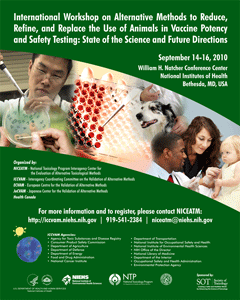Workshop on Alternative Methods to Reduce, Refine, and Replace the Use of Animals in Vaccine Potency and Safety Testing
September 14-16, 2010
William H. Natcher Conference Center - National Institutes of Health
Bethesda, MD, USA
The goals of this workshop were to:
- Review the state of the science of alternative methods that are currently available and/or accepted for use that reduce, refine, and replace the use of animals in vaccine potency and safety testing, and discuss ways to promote their implementation
- Identify knowledge and data gaps that must be addressed to develop alternative methods that can further reduce, refine, and replace the use of animals in vaccine potency and safety testing
- Identify and prioritize research, development, and validation efforts needed to address these knowledge and data gaps in order to advance alternative methods for vaccine potency and safety testing, while ensuring continued protection of human and animal health
Workshop Overview
Nearly 200 scientists from 13 countries gathered at this workshop to review the current state of the science and to recommend future research, development, and validation needed to advance alternative methods that can reduce, refine, and replace the use of animals for human and veterinary vaccine post-licensing potency and safety testing. The workshop was organized by NICEATM and ICCVAM in partnership with the European Centre for the Validation of Alternative Methods, the Japanese Center for the Validation of Alternative Methods, and Health Canada. The workshop was co-sponsored by the Society of Toxicology.
Vaccines represent a vital and cost-effective tool in the prevention of numerous infectious diseases. The importance of vaccines to human and animal health is underscored by a number of factors, including increasing occurrence of antibiotic-resistant bacteria, the growing concern about diseases in domestic animals and wildlife that can be passed on to humans, and the priority given by the World Health Organization to the eradication of a number of diseases.
In recent years, efforts have increased to develop alternative methods that reduce, refine, and replace the use of animals for vaccine potency and safety testing. However, these tests still account for the largest numbers of animals that experience unrelieved pain and distress. Implementation of the recommendations of this workshop is expected to advance the availability of alternative methods for vaccine potency and safety testing while ensuring continued protection of human and animal health.
Selected U.S. and International Regulations and Guidances
- Minimum Requirements for Biological Products (2006)
National Institute of Infectious Diseases, Japan - ICH Harmonised Tripartite Guideline
Specifications: Test Procedures and Acceptance Criteria for Biotechnological/Biological Products (1999)
International Conference on Harmonisation of Technical Requirements for Registration of Pharmaceuticals for Human Use - 21 CFR Part 610: General Biological Products Standards (2008)
Food and Drug Administration, USA - General Requirements for the Production and Control of Live and Inactivated Vaccines intended for Fish (1994)
European Medicines Evaluation Agency - Guidance for Sponsors: Lot Release Program for Schedule D (Biologic) Drugs (2005)
Health Canada - Requirements for Diptheria, Tetanus, Pertussis, and Combined Vaccines (1989)
Amendments (2003)
World Health Organization
Key References (compiled June 2010)


